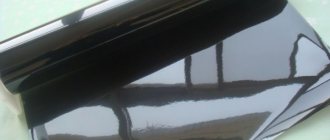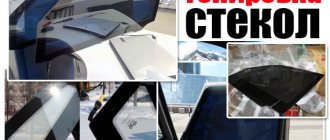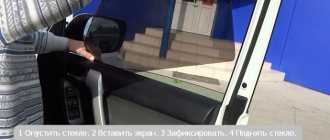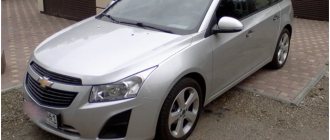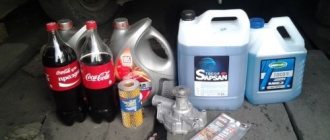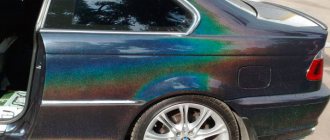A car is not only a means of transportation and an opportunity to be more independent; for men it is a second home, a status indicator. And in the house you want coziness, comfort, privacy. How to achieve this effect in a car? The only solution in this case is to tint the windows . But how can you do this so that traffic police officers don’t have any complaints against you, because no one wants to pay another fine? The solution is tinting, which the device does not see. And we will tell you what it is later.
We study the positive and negative aspects of tinting
Car rear window tinting
According to the traffic rules and legislation of our country, window tinting should not interfere with the movement of the car on the road and must comply with regulatory data, otherwise the traffic police officer has every right to impose a fine and forcibly demand the removal of the tinting film. To tint or not? How not to make a mistake? Let's look at the main positive and negative aspects of using various tint films . Vehicle owners include the following positive aspects of auto tinting:
- inability to study what is inside the cabin. This makes it easier to leave things inside the car without drawing unnecessary attention to them;
- increasing the comfort of movement. In addition, during a traffic stop, visibility of what is happening inside the car is limited;
- in the event of an accident, the film holds glass fragments, preventing them from flying inside the car, protecting passengers from injury; – the film protects the interior from solar influence, preventing it from fading and heating;
- the driver is protected from the sun's rays and, at night, from car headlights that distort the view of the road surface.
Negative sides:
- tinted windows significantly reduce visibility at night, parking takes longer;
- penalties for improper glass tinting;
- high cost of work and materials.
Article on the topic: How to change lanes correctly?
Fine amounts in 2020
The punishment for darkening car windows is regulated by Part 3.1 of Article 12.5 of the Code of Administrative Offenses of the Russian Federation and is equal to a penalty of 500 rubles.
It does not depend on the percentage of light transmission of car windows and the number of tinted windows. Previously, traffic police inspectors were allowed to remove license plates for tinting windows, however, today this norm has been abolished since November 15, 2014. The standards stipulate that if a chipboard worker identifies a darkened film on the glass that does not meet light transmission standards, then a written warning will be issued indicating the deadline for removing the tint. As a rule, the period for eliminating the violation is 10 days.
However, tinting car windows remains a common phenomenon among car owners today, despite the fight against this phenomenon by traffic police inspectors. Many car owners are in no hurry to remove the tinted windows, as it is convenient - there is no bright sunlight, and in hot weather it is more comfortable in the cabin. In 2020, changes were adopted to the standards for the light transmittance of automobile glass, at the same time, penalties for tinted glass in 2020 remain at the same level. Moreover, registration warnings today are removed even for heavily tinted windows.
But still, the punishment for tinting car windows will be as follows:
1. The initial fine for identifying darkened windows will be 1,500 rubles instead of 500 rubles.
2. Repeating the violation will result in a fine of 5,000 rubles. At the same time, a repetition of the offense will be considered if the driver is punished for this violation 12 times in a year. After such a number of violations, further illegal actions of the motorist will be equated to an administrative offense, the result of which will be:
- Imposition of a large fine of up to 5,000 rubles.
- Imprisonment.
- Deprivation of driver's license.
3. In addition, the existing standards for window tinting continue to apply:
- Car owners are prohibited from covering their car windows with films of different colors or shades.
- Films with SP80 and 90 filters on car windshields remain prohibited.
Note. Only a court has the right to impose an administrative fine if the violation of darkening windows is repeated or imprisonment of the car owner for 15 days. The inspector does not have such powers.
You can watch the video to see what fines will be imposed in 2020.
( Video : “Updated traffic regulations and fines for tinting. What else awaits motorists this year?”)
Acceptable tinting
How do you know if your tint film falls within the rules and standards of the road rules? The main indicator that is checked by the traffic police inspector during a traffic stop is the light transmittance of the tint. When the film is properly glued, the darkening of the glass is almost invisible; it is glued in accordance with standard indicators and is not visible to the device for measuring the light transmittance of glass - a taumer. Please note that the permissible light transmittance rate for tinted windows is: windshield - at least 75%, side - front, at least 70%, rear - not installed. Mirror tinting is prohibited! Be sure to study this indicator before purchasing film; the indicators must be indicated on the packaging. If there is no such indicator, check with the seller. Tint films, which were often used by car enthusiasts, had standard indicators and varied in the range of 5, 15, 20, as well as 35 and 50%. The numerical index indicated the percentage of light transmission. Tinting with 100 percent light transmittance has only recently come to the market in our country, allowing it to be used without fear of negativity from the traffic police. There are several ways to tint windows:
- stick the film. The most common and inexpensive method;
- spraying method;
- electronic window tinting.
Manufacturers of tint films
Almost every car is tinted in one way or another, which is why there are many manufacturers, from a huge factory to an underground workshop. Which film is best for tinting car windows?
In Russia, for a long time, quality is what is produced in America. There is even such a concept - “American” tint film.
- Llumar
. A wide range of types and colors, durability and strength, resistance to deformation from year to year make Llumar film the leader of all possible ratings. Some car enthusiasts note the presence of excessive shine in this film, however, there are no other complaints about it. - SunTek
. A tint film with a good name from an American manufacturer. The best adhesive properties are what sets SunTeK apart from others. They say that some of its varieties take a long time to dry and do not last long, but not many people say this. - Sun Control
. Tinting film with an affordable price. The manufacturer offers matte, gradient, deeply colored and metallized films. Judging by the reviews, the black Sun Control film has a bluish tint. - Johnson
. Another American company provides a guarantee of protection against glare and produces films that absorb ultraviolet radiation up to 99%. Their advantage is quick installation and. - ZM
. Brand from the USA with a large selection. There are inexpensive films, and there are super luxury ones. There are simply painted ones, including colored ones, and there are others with a two-level metal coating.
Armolan tint film
This list does not include tinting films from Luxman and Armolan. Undoubtedly, these are premium polymers.
This list does not include tinting films from Luxman and Armolan. Undoubtedly, these are premium polymers. They are easy to install and have no distortion. The company uses high-quality dyes and two-level scratch protection. The most famous film takes worthy places in the ranking from year to year. We're talking about Kylon. Tinting film from Korea has improved heat retention properties and a cheaper price than its counterparts in this segment. It has exceptional optical clarity and a nano-ceramic coating on some types. It is also worth noting the MTF tint film. At a low price, the product has only positive reviews. Of the budget options, this film is perhaps the highest quality option. Another budget and good option is President tint film. The manufacturer is domestic, one might even say, the only one of its kind. The film is made of good materials and also has a warranty. Fast delivery, a wide range, and no markup for transportation from other countries provide the company with good prospects not only in Russia, but also abroad. In our country, for many decades, quality is what is made in America. There is even such a concept - “American” tint film. Many people mistakenly believe that this is the name of the company. All films produced in the USA and not only are called American. Often made in other countries (India or China) are passed off as made in the USA. There are many examples of this.
Miracle - film from the USA
One of the tints, which the device does not see, is produced by the company “Solar Gard” (USA). The company produces miracle tinting with 100% light transmittance. In addition to this indicator, the characteristics of solar gard tinting, which the device does not see, include heat and sound insulation, increased glass strength, and durability. The color (shade) of the glass does not change after gluing the film; solar gard tinting also does not interfere with visibility while driving and has a high degree of protection from ultraviolet radiation.
"Smart" tinting
Another type is electronic tinting SPD technology, which allows you to change the light transmittance of the glass within a few seconds and at the request of the driver, but not determined by the taumeter. Tinting can be carried out either by completely replacing the glass with three-layer smart glass, or by using film. This technology uses two types of film:
- liquid crystal, working on the principle of photoelectric effect. The main difference from the usual tint film is the connection of such tint to the car's power supply. Depending on whether current is applied, the film changes color from matte to transparent;
- electrochromic, working on a similar principle, but differing in the type of coating. In this case, the film is sensitive not only to the effects of current (force), but also to external factors (temperature, lighting).
Article on the topic: 2009-mercedes-benz-sl-class-grey-rear-angle
Types of tint film
Films for tinting have a structure consisting of several layers, which are connected to each other with an adhesive composition. Depending on what material the layers are made of, the types of films are distinguished. Layers can be metallized, carbon, polymer. In addition to the layers that limit the penetration of light, the car film has an outer coating for abrasive protection, thanks to which it does not scratch longer and does not lose its appearance and transparency.
Automotive films can be divided into the following types:
1. Colored film for car windows.
Films with pigment as part of the material. The strength of the film depends on the number of layers. However, the more there are, the lower the light transmittance of the tint film.
2. Metallized films.
Unlike the previous type, a layer of metal is sprayed onto a layer of polymer, which is additionally introduced into the structure of the film. In this case, the metallized layer can be both internal and external. One of the advantages of metallic material is its excellent ability to reflect sunlight. However, the metallized aluminum layer may interfere with the radio signal, which will reduce the quality of mobile communications.
3. Film Infinity (Infinity).
A type of metallized film in which a layer of metal is applied to the outer side. It has the same basic properties as metallic, but has a greater number of advantages due to the ability to use different metals and alloys to create metallized layers and combine them, achieving improved quality indicators. The coating has a low reflectance of light coming from inside the room, which means a clearer and undistorted view from the window.
4. Combined type.
Combines the first 2 types - color film with metal coating. Usually in such a film I make a smooth transition from one tone to another by reducing the intensity of deposition of the metal layer. This not only increases the aesthetic properties of the material, but makes it convenient in terms of practicality - the dark layer protects from sunlight, and the lower, more transparent layer maintains good transparency and visibility. Also, the combined option allows you to make some glasses darker than others. This film is usually chosen if you want to make your car stand out from others thanks to its unusual glass design.
5. Spatter films.
They do not contain dyes, and metallization is based on ion exchange. Due to this technology, the tinting film has increased wear resistance, which allows some to use their products. In addition, the appearance of the film is also improved. However, such material is more expensive.
6. Spatter-metalized.
They are a combination of several technologies: colored spatter products with a metallized coating.
7. Athermal film.
Athermal film is installed on car windows to protect the interior from overheating: high-quality athermal films block up to 90% of ultraviolet and infrared radiation, and some even more. The products have a nanoceramic coating, in which a layer of graphite is responsible for protection from UV and infrared radiation, while maintaining light transmittance.
However, athermal tinting does not create a darkening effect, so it will not be possible to hide the interior from prying eyes. But it does not cause problems with GOST requirements.
The only caveat is that the athermal film of the LA series has a blue tint, which strains the eyes and they get tired faster, so it is better to choose a film with a neutral tint of the ATR series.
8. Film for car windows “Chameleon”
“Chameleon” is a type of athermal film that has a purple tint that beautifully shimmers in different colors, which is why it got its name. Its main difference is the ability to change light transmittance depending on the brightness of sunlight. In connection with this feature, an officially unconfirmed opinion has emerged that when measuring light transmittance, indicators may vary depending on the level of illumination and the location of measurement, so you should choose this type of film with caution.
9. Strengthening protective films (anti-vandal).
Provide armor for car windows. Protective films not only strengthen the glass, but also thanks to them, when it breaks, the fragments are held in place.
10. Carbon.
A modern tint film, however, unlike others, it is glued not only to glass, but also to widespread types of carbon material that cover the surface of the car. The properties of the material resemble metallic, but without its disadvantages. Practical, durable, does not fade in the sun, does not create glare.
Carbon on the car body and parts:
How to choose a film for car tinting
Tint film, despite its practical and aesthetic advantages, can cause some problems. The main one is the deterioration of visibility, especially in the dark or in bad weather. The second is special attention from car inspectors and possible difficulties with passing technical inspection if, when choosing a tint film and its installation, you do not comply with GOST standards and the requirements of the Code of Administrative Offenses. Install only the film and in the manner permitted by current applicable standards.
So that after tinting your windows you do not have problems with traffic police officers, when choosing a tinting material, pay attention to the following characteristics:
- The light transmission parameter of the tint film is the main indicator used in the standards.
- The parameter responsible for the passage of solar energy through the film.
- Light absorption parameter - how many percent of the sun's rays are absorbed by the tinting.
- Reflection parameter - how much sunlight will be reflected from the surface of tinted glass.
- Transmittance for UV rays.
